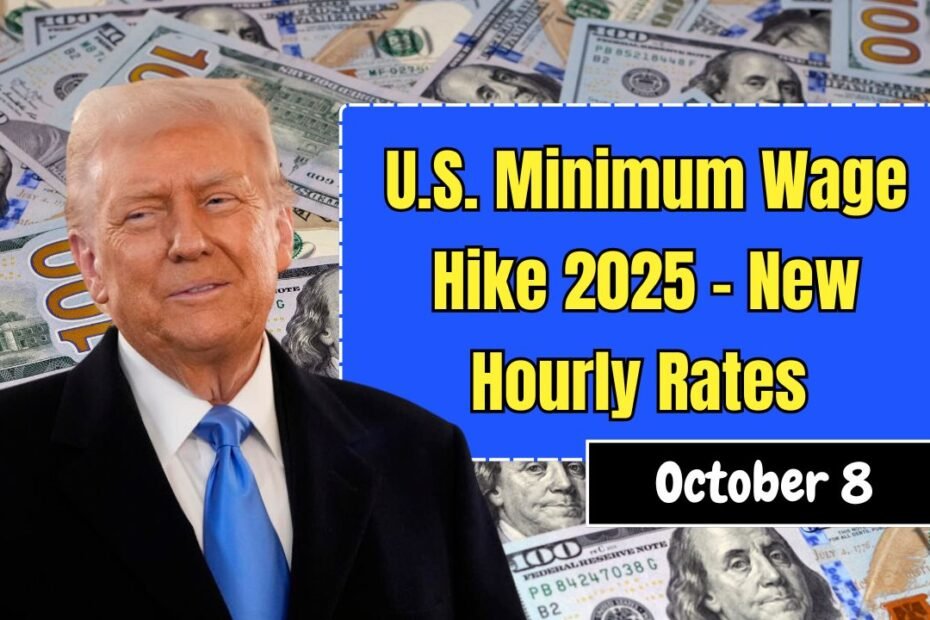The United States is poised for a historic change in wage standards as a proposed federal minimum wage increase is scheduled to take effect on October 8, 2025.
Under the new regulation, millions of hourly workers in both the public and private sectors will benefit from higher wage floors, potentially marking a turning point in efforts to address wage stagnation, inflation, and income inequality.
What’s Changing: The New Federal Minimum Wage
Starting October 8, 2025, the federal minimum wage will increase from $7.25 per hour (where it has remained since 2009) to a new baseline.
While the exact new rate has been the subject of negotiations and legislative proposals, the draft versions suggest an increase to $10.00 per hour. This new minimum aims to provide significant relief for low-wage workers nationwide.
This change is part of broader momentum in Washington toward updating wage policy. The Raise the Wage Act of 2025 supports incremental increases toward a $17 federal minimum by 2030, phasing out subminimum rates for tipped workers and those with disabilities.
State & Local Variations Still Apply
Even with the new federal rate active, many state and city minimum wages already exceed the federal floor. Where local rates are higher, they will continue to prevail. Here are a few examples of where wages already surpass or align with the new federal baseline:
| State / Locale | Existing Minimum / Scheduled 2025 Rate | Status vs. Federal |
|---|---|---|
| California | $16.00+ (varies by region) | Remains higher than federal |
| New York | $15.50 statewide (higher in NYC) | Unaffected by federal increase |
| Florida | $12.00 (rising gradually) | Exceeds federal floor |
| Texas | $7.25 (federal baseline) | Matches new federal rate |
| Many states (e.g. in the South / Midwest) | $7.25 | Will rise to new federal minimum |
Impact on Workers
For workers at the current bottom tier:
- Monthly earnings increase: A full-time (40 hours/week) worker would see annual pay go from ~$15,080 to $20,800, before taxes and deductions.
- Cost of living compensation: The increase helps offset inflation in housing, food, healthcare, and transportation costs.
- Reduced need for aid: As wages rise, reliance on public assistance may decrease, freeing up resources for other social programs.
- Boost in spending: Lower-income households tend to spend extra income immediately, stimulating demand in the economy.
Challenges for Employers
While beneficial to workers, employers — especially small and medium businesses — will face challenges:
- Labor cost increase: A substantial rise in wages means recalculating budgets and margins.
- Potential price adjustments: Some businesses may raise prices to offset higher payroll.
- Workforce restructuring: Employers may reduce hours or review staffing models to manage cost.
- Transition compliance: Payroll systems, contracts, and HR policies must be updated to reflect the new rate and avoid penalties.
The Great Debate: Wages, Inflation & Employment
This hike is partly a response to years of inflationary pressure and wage stagnation. Many low-wage workers have felt squeezed by rising costs with stagnant pay. Proponents argue that this increase restores purchasing power and helps narrow income inequality.
Critics warn that a sudden wage boost may contribute to job losses or reduced hours if some businesses cannot absorb the added costs.
However, economic models often show gains in consumer spending can offset some of the risk to employment, especially in lower-wage sectors.
How It Affects Young, Part-Time & Tipped Workers
The increase is particularly meaningful for part-time workers, students, and entry-level employees, who often dominate the bottom wage tiers.
Those who rely on tips or work limited hours may see more stability in base wages. Employers may respond by adjusting scheduling or staffing to adapt, but the net benefit is expected to be positive for millions in this group.
The U.S. minimum wage hike effective October 8, 2025 marks a significant leap forward in federal wage policy. Moving from $7.25 to $10.00 per hour provides real financial relief for millions of low-wage workers and reflects a growing emphasis on fairness and living wages.
While some businesses may feel pressure from increased costs, the broader economic benefits — from higher consumer spending to improved worker retention — could deliver lasting positive change.
Stay alert, check your pay, and ensure that both workers and employers adapt smoothly to this new era of wage growth.
FAQs
What is the new federal minimum wage starting October 8, 2025?
It is expected to rise from $7.25 to $10.00 per hour under the new legislation.
Do states with higher minimum wages get affected?
No — states, cities, or municipalities with existing minimums above the new federal rate will continue their current, higher rates.
How much will a full-time minimum wage worker gain annually?
Under a 40-hour workweek, the increase would boost annual pre-tax income from ~$15,080 to ~$20,800.



